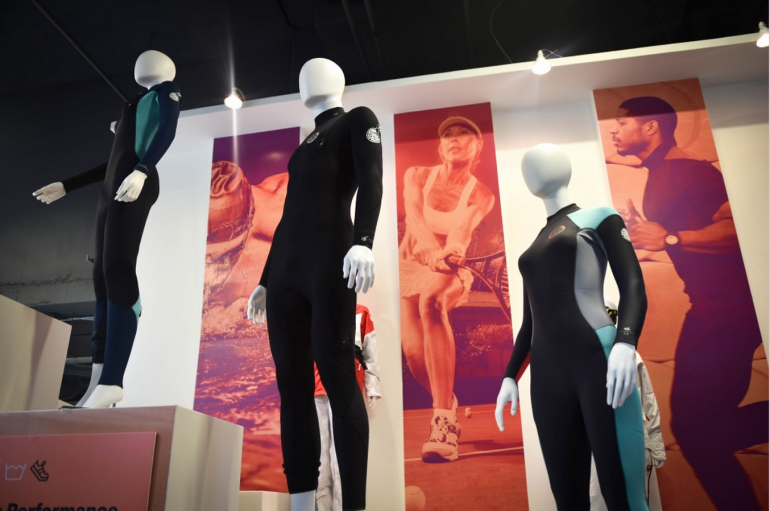For more than a hundred years, sports have been synthesizing fashion and function to offer garments that stretch the limits of what we demand from our clothing. At the same time, sport signifies lifestyle and inspires fashion well beyond the track or the tennis court (think Polo Ralph Lauren, Lacoste, and even Lululemon).
On the heels of the Pan Am Games, which took over the city of Toronto July 10th, an exhibition invites us to consider how the relationship between fashion and technology comes into play in sports and performance.
“Smarter. Faster. Tougher: An Exhibition on Sports, Fashion and Technology” is curated by Marie O’Mahony, the woman who literally wrote the book on technology and textiles. The exhibit features everything from 3D-printed bikinis to smart garments that measure your biometric data to wetsuits designed to repel sharks.

Housed just a short sprint away from the Athlete’s Village at 39 Parliament Street, the exhibit is one in a series of Design Exchange satellite events that aim to provide unique and accessible programming to the public. Shauna Levy, President and CEO of the Design Exchange, remarked, “If we can demonstrate how design and innovation are relevant to the world of sports, than we’ve accomplished demonstrating how design is important in everyday life.”

The exhibition is made up of four main zones, each with its own focus. Zone One hones in on performance, and how clothing supports the wearer by providing smartness, strength, and ergonomic support (think wetsuits, ski jackets, and running shirts).

Zone Two (the “fashion zone”) explores the ways leading fashion designers are influenced by the aesthetic and performance of sport. For example, Alexander Wang’s collaboration with retail company H&M, which drew inspiration from scubawear.




Zone Three showcases nature and the impact of the natural world on sportswear. Perhaps the easiest example of this is camouflage, a pattern developed to disguise military personnel in an attempt to make them blend in with their surroundings.


Last but not least, Zone Four looks at ethnography and ponders the relationship between culture and design. An example that’s close to home for Canadian audiences is the Canada Goose jacket, a high-performance parka that has almost become like a winter uniform amongst urban Canadians.

Beyond high-performance fabrics, the exhibit includes a number of pieces that highlight the relationship between digital technology and fashion, such as the below display, which was a collaboration between U.K. digital creative studio Holition and Lacoste.

The exhibit also featured a number of wearable technologies, such as OMSignal’s Adventure Fitness Long Sleeve, and considered how fashion tech developed for professional sports penetrate into the mainstream.
“These kinds of technologies, they’re not just for the elite athletes,” said O’Mahony, “They may start off in that sense, but they’re also coming into stores so that everybody can wear these materials.” Case in point: Hexoskin’s biometric smart shirt, which is now available to Canadian consumers via Best Buy Canada).

“The sportswear market is valued at almost $800 billion,” said O’Mahony. “But sportswear is valuable beyond its financial contribution; it touches everything from innovation to culture to well-being.”
Smarter. Faster. Tougher: An Exhibition of Sports, Fashion + Tech runs through October 12th at 39 Parliament in Toronto, Ontario.





